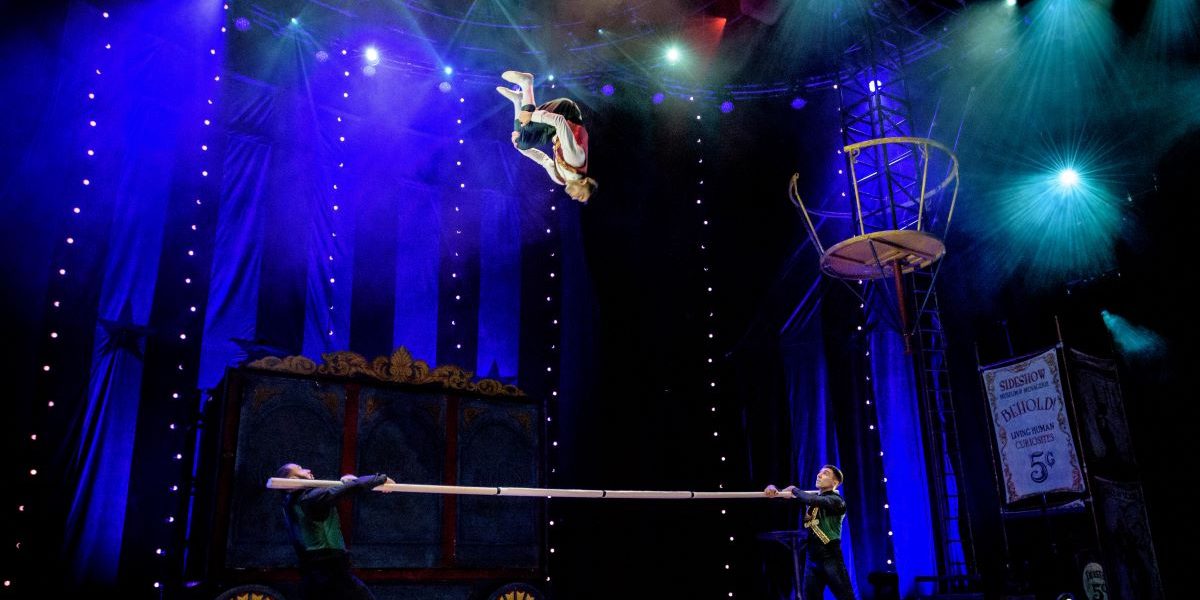This is not the first time that the circus has come to one of the capital’s long-established concert venues. Cirque du Soleil, for example, is now a regular visitor to London’s Theatreland. But Circus 1903 has now produced a rival for artistry and excitement. The transition from the big top to the stage gives a different perspective on just how amazing the achievements of circus artistes can be. With an irrepressible ringmaster, but without a ring – and for that matter, without much popcorn, despite the ringmaster’s teasing distribution of freebies – the stage of the lovely art deco Eventim Apollo (formerly the Hammersmith Odeon) was the setting last night for a fast-moving succession of remarkable acts that captivated the adults in the audience just as much as the children. The performers were egged on with much clapping and cheering, and at the end they were given a standing ovation. They deserved it.
Each of the acts was really good, and it seems invidious to pick any out for special mention. But here are three that particularly struck this reviewer.
A fairly small case is carried onto the stage, and we are told there is someone inside. Surely the case is too small? Are we about to behold a ghastly fairground freak? No. Instead, there emerges a svelte and perfectly formed, indeed very beautiful, young woman from Ethiopia who, balancing on her hands, arches her back until her feet are in front of her head. With a sweet smile on her face all the while, she proceeds to execute a series of contortions that would overturn the theories of an anatomist.
Teetering on the brink of disaster come a troupe of swaggering hunks. With pectorals and biceps bulging, and with more six packs than Carlings, they catapult themselves into the air from a see-saw (called a teeterboard), and get up so high they can perform several flick-flacks or somersaults before coming down. Is there a hard landing? Well, sometimes they land feet-first on the see-saw itself, sometimes they fly so far that they have to break their fall with a mattress.
By contrast, perhaps the most astonishing feat of acrobatics is performed by a pair of diminutive Ethiopian brothers, one of whom lies on his back and, with his feet in the air, and with his brother lying outstretched on top, whirls the latter around like a spinning top. The smaller one then uses his sibling as a launch pad, and indeed as a landing platform, for a giddy series of aerial somersaults. Eye-watering stuff.
For me, however, the highest accolade must go to perhaps the unlikeliest contender. This is the Ringmaster himself. A showman extraordinaire, he holds the whole thing together with his continuity patter and his wisecracks, and his quickfire responses to whatever comes up. The unexpected does indeed come up when he brings children onto the stage. Ignoring the advice of W.C. Fields, the Ringmaster gets cuties to volunteer to take part in various games, and manages not to be upstaged by them. This may sound twee, but it is genuinely funny without making fun of the children, a refreshing antidote to over-protectiveness. The Ringmaster even waxes philosophical at times, when he talks about the phenomenon of the circus, and its history. What a showman! Watch out, Hugh Jackman …
But what about the elephant in the room? There are two, actually – an enormous African she-elephant and her calf, brought to the stage by the puppeteers who created War Horse. In the wild, the adult elephant is a noble creature, and this nobility, indeed gravitas, is embodied in their new creation. There is, of course, playfulness in the calf. Why the elephants are there, and why the year 1903 is part of the show’s title, is explained in the instructive souvenir programme. Unlike many theatre programmes, this one does not consist just of flattering photographs of everyone involved plus their CVs.
All in all, this show will be a highlight of their Festive Season for anyone who goes to see it.

